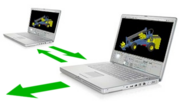Difference between revisions of "Main Page/print"
| Line 1: | Line 1: | ||
| + | __NOEDITSECTION__ | ||
{{expand print|Introduction}} | {{expand print|Introduction}} | ||
| + | {{expand print|Open collaborative design}} | ||
<!-- | <!-- | ||
| − | |||
{{frame more1|Fundamental resources}} | {{frame more1|Fundamental resources}} | ||
{{frame more1|Survival of our species}} | {{frame more1|Survival of our species}} | ||
Revision as of 02:27, 12 February 2007
Introduction
Not even close. Our present culture is conditioned by centuries of scarcity that ought to have disappeared by now, considering our technical capabilities.
However, automation is advancing rapidly, and in parallel, we are developing ever more effective ways of collaborating and openly sharing knowledge. This means it will become increasingly unacceptable to let needless scarcity continue in the face of what is possible. New thinking and tools are emerging that could change everything.
Via the internet a new fluid grouping of minds is evolving that is adhoc, distributed and mutually sharing – a system that is potentially far more effective at problem-solving and creative technical development than anything that has come before. In some areas, notably software development and knowledge gathering, it is well under way – but this is just the beginning. These 'open' peer-to-peer activities are about to burst out into the physical world enabling us to do things both technologically and economically that have not previously been feasible.
AdCiv.org is exploring the emerging possibilities, focusing on developing concepts that could take us to the next logical phase of civilisation – namely an ecologically sympathetic post-scarcity age where abundant resources, tools and knowledge could enable a unparalleled standard of living for the entire growing global population. It may sound far-fetched to the uninitiated but the technologies to enable this are developing rapidly, so you might want to prepare yourself...
Open collaborative design
Open collaborative design involves applying principles from the remarkable free and open-source software movement that provides a powerful new way to design physical objects, machines and systems. All information involved in creating the object or system is made available on the Internet – such as text, drawings, photographs and 3D computer-aided design (CAD) models – so that other people can freely re-create it, or help contribute to its further evolution. It is essentially the same principle that is used to progress scientific knowledge, however in reality it is much more open and transparent than much of contemporary scientific research.A core element of this development model is a principle called 'copyleft'  (symbol:
(symbol: ![]() ) which is a way of applying copyright to a creative work in a way that makes sure that anyone can freely use it or build upon it - and also that derivative works inherit the same terms, ensuring anything based on the original is freely available too. This principle means that 'copylefted' items – whether they are designs, text, artwork or computer code – are effectively gifted to humanity, adding to an ever increasing universal 'commons'. Because this principle is to the benefit of everyone, it completely changes the way that many people think about contributing their time and effort to this type of project. It already works very effectively with many high profile, successful software projects, so this is not merely wishful thinking.
) which is a way of applying copyright to a creative work in a way that makes sure that anyone can freely use it or build upon it - and also that derivative works inherit the same terms, ensuring anything based on the original is freely available too. This principle means that 'copylefted' items – whether they are designs, text, artwork or computer code – are effectively gifted to humanity, adding to an ever increasing universal 'commons'. Because this principle is to the benefit of everyone, it completely changes the way that many people think about contributing their time and effort to this type of project. It already works very effectively with many high profile, successful software projects, so this is not merely wishful thinking.
Open collaborative design is a nascent field that has huge potential to radically alter the way we create goods, machines and systems – not only for personal items but all the way up to components of national or global infrastructure. 

